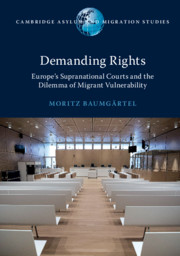Book contents
- Demanding Rights
- Cambridge Asylum and Migration Studies
- Demanding Rights
- Copyright page
- Contents
- Figures
- Tables
- Series Editor’s Preface
- Foreword
- Acknowledgements
- List of Abbreviations
- Part I
- 1 Introduction
- 2 Expanding the Rights to Stay?
- 3 Establishing Responsibility?
- 4 Reaffirming Jurisdiction?
- Part II
- Appendix
- Bibliography
- Index
3 - Establishing Responsibility?
from Part I
Published online by Cambridge University Press: 03 May 2019
- Demanding Rights
- Cambridge Asylum and Migration Studies
- Demanding Rights
- Copyright page
- Contents
- Figures
- Tables
- Series Editor’s Preface
- Foreword
- Acknowledgements
- List of Abbreviations
- Part I
- 1 Introduction
- 2 Expanding the Rights to Stay?
- 3 Establishing Responsibility?
- 4 Reaffirming Jurisdiction?
- Part II
- Appendix
- Bibliography
- Index
Summary
- Type
- Chapter
- Information
- Demanding RightsEurope's Supranational Courts and the Dilemma of Migrant Vulnerability, pp. 46 - 80Publisher: Cambridge University PressPrint publication year: 2019

